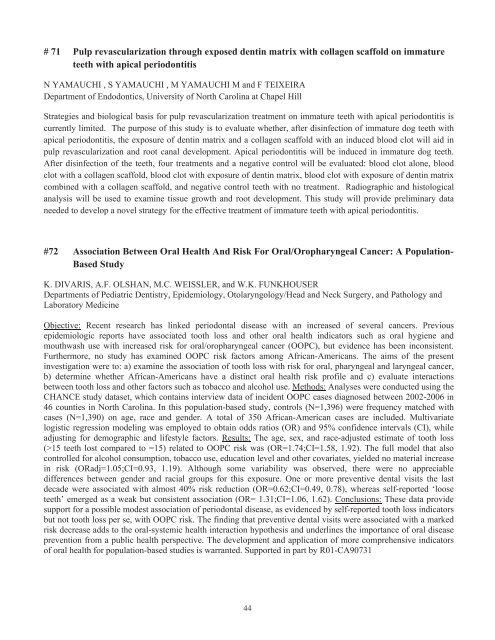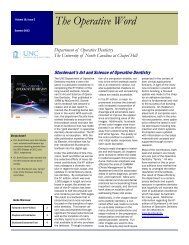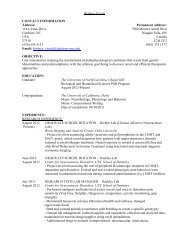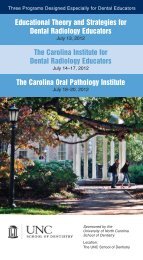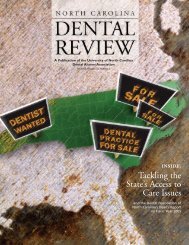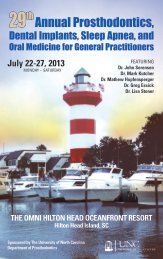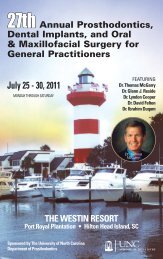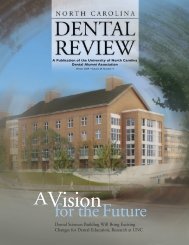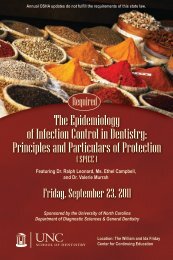UNC School of Dentistry - The University of North Carolina at ...
UNC School of Dentistry - The University of North Carolina at ...
UNC School of Dentistry - The University of North Carolina at ...
Create successful ePaper yourself
Turn your PDF publications into a flip-book with our unique Google optimized e-Paper software.
# 71 Pulp revasculariz<strong>at</strong>ion through exposed dentin m<strong>at</strong>rix with collagen scaffold on imm<strong>at</strong>ureteeth with apical periodontitisN YAMAUCHI , S YAMAUCHI , M YAMAUCHI M and F TEIXEIRADepartment <strong>of</strong> Endodontics, <strong>University</strong> <strong>of</strong> <strong>North</strong> <strong>Carolina</strong> <strong>at</strong> Chapel HillStr<strong>at</strong>egies and biological basis for pulp revasculariz<strong>at</strong>ion tre<strong>at</strong>ment on imm<strong>at</strong>ure teeth with apical periodontitis iscurrently limited. <strong>The</strong> purpose <strong>of</strong> this study is to evalu<strong>at</strong>e whether, after disinfection <strong>of</strong> imm<strong>at</strong>ure dog teeth withapical periodontitis, the exposure <strong>of</strong> dentin m<strong>at</strong>rix and a collagen scaffold with an induced blood clot will aid inpulp revasculariz<strong>at</strong>ion and root canal development. Apical periodontitis will be induced in imm<strong>at</strong>ure dog teeth.After disinfection <strong>of</strong> the teeth, four tre<strong>at</strong>ments and a neg<strong>at</strong>ive control will be evalu<strong>at</strong>ed: blood clot alone, bloodclot with a collagen scaffold, blood clot with exposure <strong>of</strong> dentin m<strong>at</strong>rix, blood clot with exposure <strong>of</strong> dentin m<strong>at</strong>rixcombined with a collagen scaffold, and neg<strong>at</strong>ive control teeth with no tre<strong>at</strong>ment. Radiographic and histologicalanalysis will be used to examine tissue growth and root development. This study will provide preliminary d<strong>at</strong>aneeded to develop a novel str<strong>at</strong>egy for the effective tre<strong>at</strong>ment <strong>of</strong> imm<strong>at</strong>ure teeth with apical periodontitis.#72 Associ<strong>at</strong>ion Between Oral Health And Risk For Oral/Oropharyngeal Cancer: A Popul<strong>at</strong>ion-Based StudyK. DIVARIS, A.F. OLSHAN, M.C. WEISSLER, and W.K. FUNKHOUSERDepartments <strong>of</strong> Pedi<strong>at</strong>ric <strong>Dentistry</strong>, Epidemiology, Otolaryngology/Head and Neck Surgery, and P<strong>at</strong>hology andLabor<strong>at</strong>ory MedicineObjective: Recent research has linked periodontal disease with an increased <strong>of</strong> several cancers. Previousepidemiologic reports have associ<strong>at</strong>ed tooth loss and other oral health indic<strong>at</strong>ors such as oral hygiene andmouthwash use with increased risk for oral/oropharyngeal cancer (OOPC), but evidence has been inconsistent.Furthermore, no study has examined OOPC risk factors among African-Americans. <strong>The</strong> aims <strong>of</strong> the presentinvestig<strong>at</strong>ion were to: a) examine the associ<strong>at</strong>ion <strong>of</strong> tooth loss with risk for oral, pharyngeal and laryngeal cancer,b) determine whether African-Americans have a distinct oral health risk pr<strong>of</strong>ile and c) evalu<strong>at</strong>e interactionsbetween tooth loss and other factors such as tobacco and alcohol use. Methods: Analyses were conducted using theCHANCE study d<strong>at</strong>aset, which contains interview d<strong>at</strong>a <strong>of</strong> incident OOPC cases diagnosed between 2002-2006 in46 counties in <strong>North</strong> <strong>Carolina</strong>. In this popul<strong>at</strong>ion-based study, controls (N=1,396) were frequency m<strong>at</strong>ched withcases (N=1,390) on age, race and gender. A total <strong>of</strong> 350 African-American cases are included. Multivari<strong>at</strong>elogistic regression modeling was employed to obtain odds r<strong>at</strong>ios (OR) and 95% confidence intervals (CI), whileadjusting for demographic and lifestyle factors. Results: <strong>The</strong> age, sex, and race-adjusted estim<strong>at</strong>e <strong>of</strong> tooth loss(>15 teeth lost compared to =15) rel<strong>at</strong>ed to OOPC risk was (OR=1.74;CI=1.58, 1.92). <strong>The</strong> full model th<strong>at</strong> alsocontrolled for alcohol consumption, tobacco use, educ<strong>at</strong>ion level and other covari<strong>at</strong>es, yielded no m<strong>at</strong>erial increasein risk (ORadj=1.05;CI=0.93, 1.19). Although some variability was observed, there were no appreciabledifferences between gender and racial groups for this exposure. One or more preventive dental visits the lastdecade were associ<strong>at</strong>ed with almost 40% risk reduction (OR=0.62;CI=0.49, 0.78), whereas self-reported ‘looseteeth’ emerged as a weak but consistent associ<strong>at</strong>ion (OR= 1.31;CI=1.06, 1.62). Conclusions: <strong>The</strong>se d<strong>at</strong>a providesupport for a possible modest associ<strong>at</strong>ion <strong>of</strong> periodontal disease, as evidenced by self-reported tooth loss indic<strong>at</strong>orsbut not tooth loss per se, with OOPC risk. <strong>The</strong> finding th<strong>at</strong> preventive dental visits were associ<strong>at</strong>ed with a markedrisk decrease adds to the oral-systemic health interaction hypothesis and underlines the importance <strong>of</strong> oral diseaseprevention from a public health perspective. <strong>The</strong> development and applic<strong>at</strong>ion <strong>of</strong> more comprehensive indic<strong>at</strong>ors<strong>of</strong> oral health for popul<strong>at</strong>ion-based studies is warranted. Supported in part by R01-CA9073144


